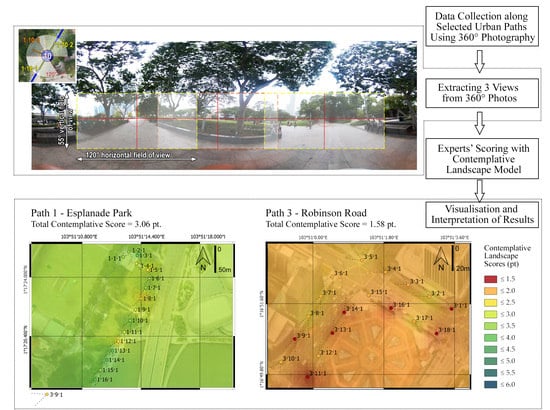Visual Quality Assessment of Urban Scenes with the Contemplative Landscape Model: Evidence from a Compact City Downtown Core
Abstract
1. Introduction
1.1. Contemplative Landscape Model
1.2. Mental Health and Urban Greening in Singapore
1.3. Research Objectives
2. Materials and Methods
2.1. Study Site Selection
2.2. Photographic Data Collection
2.3. Urban Scene Evaluation with CLM
2.4. Spatial Visualization and Analysis
3. Results
3.1. CL Scores of Scenes
3.2. CL Scores of Paths
3.3. Spatial Visualization Map
4. Discussion
4.1. Summary of Findings, Contributions and Limitations of the Study
4.2. Explanation of Scoring and Design Recommendations
- Introducing natural asymmetry through undulating landforms or natural lines can improve the landform score.
- Introducing a wider variety of plant species, with seasonally changing forms and colors, in the seemingly natural compositions can improve the score for vegetation.
- Changing the width of a path or introducing a different, narrower boulevard pattern can improve the archetypal elements score.
- Providing more comfortable seating with visual divisions to provide a sense of solitude can improve the character of peace and silence score.
5. Conclusions
Author Contributions
Funding
Acknowledgments
Conflicts of Interest
References
- Whiteford, H.A.; Ferrari, A.J.; Degenhardt, L.; Feigin, V.; Vos, T. Global burden of mental, neurological, and substance use disorders: An analysis from the Global Burden of Disease Study 2010. Ment. Neurol. Subst. Use Disord. 2015, 29. [Google Scholar] [CrossRef] [PubMed]
- Steel, Z.; Marnane, C.; Iranpour, C.; Chey, T.; Jackson, J.W.; Patel, V.; Silove, D. The global prevalence of common mental disorders: A systematic review and meta-analysis 1980–2013. Int. J. Epidemiol. 2014, 43, 476–493. [Google Scholar] [CrossRef] [PubMed]
- World Health Organization. Mental Health Action Plan 2013–2020. 2013. Available online: https://www.who.int/mental_health/publications/action_plan/en/ (accessed on 26 October 2020).
- Becker, A.E.; Kleinman, A. Mental health and the global agenda. N. Engl. J. Med. 2013, 369, 66–73. [Google Scholar] [CrossRef]
- World Health Organization. Mental Health and Psychosocial Considerations during the COVID-19 Outbreak, 18 March 2020; World Health Organization: Geneva, Switzerland, 2020. [Google Scholar]
- Pfefferbaum, B.; North, C.S. Mental Health and the Covid-19 Pandemic. N. Engl. J. Med. 2020, 383, 510–512. [Google Scholar] [CrossRef] [PubMed]
- Holmes, E.A.; O’Connor, R.C.; Perry, V.H.; Tracey, I.; Wessely, S.; Arseneault, L.; Ballard, C.; Christensen, H.; Cohen Silver, R.; Everall, I.; et al. Multidisciplinary research priorities for the COVID-19 pandemic: A call for action for mental health science. Lancet Psychiatry 2020, 7, 547–560. [Google Scholar] [CrossRef]
- Norman, R.E.; Carpenter, D.O.; Scott, J.; Brune, M.N.; Sly, P.D. Environmental exposures: An underrecognized contribution to noncommunicable diseases. Rev. Environ. Health 2013, 28, 59–65. [Google Scholar] [CrossRef]
- Helbich, M. Toward dynamic urban environmental exposure assessments in mental health research. Environ. Res. 2018, 161, 129–135. [Google Scholar] [CrossRef]
- De Bloom, J.; Kinnunen, U.; Korpela, K. Exposure to nature versus relaxation during lunch breaks and recovery from work: Development and design of an intervention study to improve workers’ health, well-being, work performance and creativity. BMC Public Health 2014, 14, 488. [Google Scholar] [CrossRef]
- Peen, J.; Schoevers, R.A.; Beekman, A.T.; Dekker, J. The current status of urban-rural differences in psychiatric disorders. Acta Psychiatr. Scand. 2010, 121, 84–93. [Google Scholar] [CrossRef]
- Van den Berg, A.E.; Hartig, T.; Staats, H. Preference for Nature in Urbanized Societies: Stress, Restoration, and the Pursuit of Sustainability. J. Soc. Issues 2007, 63, 79–96. [Google Scholar] [CrossRef]
- Triguero-Mas, M.; Gidlow, C.J.; Martínez, D.; De Bont, J.; Carrasco-Turigas, G.; Martínez-Íñiguez, T.; Hurst, G.; Masterson, D.; Donaire-Gonzalez, D.; Seto, E. The effect of randomised exposure to different types of natural outdoor environments compared to exposure to an urban environment on people with indications of psychological distress in Catalonia. PLoS ONE 2017, 12, e0172200. [Google Scholar] [CrossRef] [PubMed]
- Kaplan, S. Meditation, Restoration, and the Management of Mental Fatigue. Environ. Behav. 2001, 33, 480–506. [Google Scholar] [CrossRef]
- Carrus, G.; Scopelliti, M.; Lafortezza, R.; Colangelo, G.; Ferrini, F.; Salbitano, F.; Agrimi, M.; Portoghesi, L.; Semenzato, P.; Sanesi, G. Go greener, feel better? The positive effects of biodiversity on the well-being of individuals visiting urban and peri-urban green areas. Landsc. Urban Plan. 2015, 134, 221–228. [Google Scholar] [CrossRef]
- Jo, H.; Song, C.; Ikei, H.; Enomoto, S.; Kobayashi, H.; Miyazaki, Y. Physiological and Psychological Effects of Forest and Urban Sounds Using High-Resolution Sound Sources. Int. J. Environ. Res. Public Health 2019, 16, 2649. [Google Scholar] [CrossRef] [PubMed]
- Berman, M.G.; Jonides, J.; Kaplan, S. The cognitive benefits of interacting with nature. Psychol. Sci. 2008, 19, 1207–1212. [Google Scholar] [CrossRef]
- Bratman, G.N.; Anderson, C.B.; Berman, M.G.; Cochran, B.; de Vries, S.; Flanders, J.; Folke, C.; Frumkin, H.; Gross, J.J.; Hartig, T.; et al. Nature and mental health: An ecosystem service perspective. Sci. Adv. 2019, 5, eaax0903. [Google Scholar] [CrossRef]
- Olszewska-Guizzo, A.A.; Paiva, T.O.; Barbosa, F. Effects of 3D Contemplative Landscape Videos on Brain Activity in a Passive Exposure EEG Experiment. Front. Psychiatry 2018, 9, 317. [Google Scholar] [CrossRef]
- Olszewska-Guizzo, A.; Sia, A.; Fogel, A.; Ho, R. Can Exposure to Certain Urban Green Spaces Trigger Frontal Alpha Asymmetry in the Brain?—Preliminary Findings from a Passive Task EEG Study. Int. J. Environ. Res. Public Health 2020, 17, 394. [Google Scholar] [CrossRef]
- Olszewska, A.A.; Marques, P.F.; Ryan, R.L.; Barbosa, F. What makes a landscape contemplative? Environ. Plan. B Urban. Anal. City Sci. 2016, 45, 7–25. [Google Scholar] [CrossRef]
- Olszewska, A.A. Contemplative Values of Urban Parks and Gardens: Applying Neuroscience to Landscape Architecture; Universidade do Porto: Porto, Portugal, 2016. [Google Scholar]
- Masoudi, M.; Tan, P.Y.; Liew, S.C. Multi-city comparison of the relationships between spatial pattern and cooling effect of urban green spaces in four major Asian cities. Ecol. Indic. 2019, 98, 200–213. [Google Scholar] [CrossRef]
- Latest Nationwide Study Shows 1 in 7 people in Singapore Has Experienced a Mental Disorder in Their Lifetime. Institute of Mental Health. Available online: www.imh.com.sg (accessed on 11 December 2019).
- Chew, V. Singapore Green Plan. Singap. Infopedia 2016. Available online: https://eresources.nlb.gov.sg/infopedia/articles/SIP_1370_2008-11-22.html (accessed on 26 October 2020).
- Yeo, B.L. The Singapore green plan. 1994. Available online: https://dr.ntu.edu.sg/bitstream/10356/93076/1/AMIC_1994_APR8-9_12.pdf (accessed on 26 October 2020).
- Guidelines on Greenery Provision and Tree Conservation for Developments, 3rd ed.; Singapore, 2019; p. 213. Available online: https://www.nparks.gov.sg/partner-us/development-plan-submission/guidelines-on-greenery-provision-and-tree-conservation-for-developments (accessed on 26 October 2020).
- Liu, H.-L.; Shen, Y.-S. The impact of green space changes on air pollution and microclimates: A case study of the Taipei metropolitan area. Sustainability 2014, 6, 8827–8855. [Google Scholar] [CrossRef]
- Ouyang, W.; Skidmore, A.K.; Toxopeus, A.G.; Hao, F. Long-term vegetation landscape pattern with non-point source nutrient pollution in upper stream of Yellow River basin. J. Hydrol. 2010, 389, 373–380. [Google Scholar] [CrossRef]
- Prevedello, J.A.; Almeida--Gomes, M.; Lindenmayer, D.B. The importance of scattered trees for biodiversity conservation: A global meta-analysis. J. Appl. Ecol. 2018, 55, 205–214. [Google Scholar] [CrossRef]
- Gascon, M.; Triguero-Mas, M.; Martínez, D.; Dadvand, P.; Forns, J.; Plasència, A.; Nieuwenhuijsen, M.J. Mental health benefits of long-term exposure to residential green and blue spaces: A systematic review. Int. J. Environ. Res. Public Health 2015, 12, 4354–4379. [Google Scholar] [CrossRef]
- Fong, K.C.; Hart, J.E.; James, P. A Review of Epidemiologic Studies on Greenness and Health: Updated Literature Through 2017. Curr. Environ. Health Rep. 2018, 5, 77–87. [Google Scholar] [CrossRef]
- Sandifer, P.A.; Sutton-Grier, A.E.; Ward, B.P. Exploring connections among nature, biodiversity, ecosystem services, and human health and well-being: Opportunities to enhance health and biodiversity conservation. Ecosyst. Serv. 2015, 12, 1–15. [Google Scholar] [CrossRef]
- Treib, M. Attending. In Contemporary Landscapes of Contemplation; Krinke, R., Ed.; Routledge: London, UK, 2005; pp. 27–49. [Google Scholar]
- Gobster, P.H. Visions of nature: Conflict and compatibility in urban park restoration. Landsc. Urban Plan. 2001, 56, 35–51. [Google Scholar] [CrossRef]
- Skalski, J. Komfort dalekiego patrzenia jako czynnik wartościujący przestrzeń publiczną miasta. Czas. Technol. Archit. 2007, 104, 163–167. [Google Scholar]
- Jung, C.G. The Archetypes and the Collective Unconscious; Routledge: London, UK, 2014. [Google Scholar]
- Frumkin, H.; Bratman, G.N.; Breslow, S.J.; Cochran, B.; Kahn, P.H., Jr.; Lawler, J.J.; Levin, P.S.; Tandon, P.S.; Varanasi, U.; Wolf, K.L. Nature contact and human health: A research agenda. Environ. Health Perspect. 2017, 125, 075001. [Google Scholar] [CrossRef] [PubMed]
- Van den Bosch, M. Live long in nature and long live nature! Lancet Planet. Health 2017, 1, e265–e266. [Google Scholar] [CrossRef]
- Andreucci, M.B.; Russo, A.; Olszewska-Guizzo, A. Designing Urban Green Blue Infrastructure for Mental Health and Elderly Wellbeing. Sustainability 2019, 11, 6425. [Google Scholar] [CrossRef]
- 2019 Cigna 360 Well-Being Survey; 2019; p. 15. Available online: wellbeing.cigna.com/ (accessed on 26 October 2020).
- Statistcs, S.D.O. Statistical Release 3: Geographic Distribution and Transport; Singapore, 2011. Available online: https://www.singstat.gov.sg/publications/cop2010/cop2010-sr3 (accessed on 26 October 2020).
- U.R.A. Our Downtown: A Place for All. Available online: https://www.ura.gov.sg/Corporate/Planning/Master-Plan/Regional-Highlights/Central-Area/Downtown (accessed on 22 July 2020).
- Panero, J.; Zelnik, M. Human Dimension & Interior Space: A Source Book of Design Reference Standards; Watson-Guptill: New York, NY, USA, 1979. [Google Scholar]
- Hsu, C.-C.; Sandford, B.A. The Delphi technique: Making sense of consensus. Pract. Assess. Res. Eval. 2007, 12, 10. [Google Scholar]
- Berry, K.J.; Mielke, P.W., Jr. A generalization of Cohen’s kappa agreement measure to interval measurement and multiple raters. Educ. Psychol. Meas. 1988, 48, 921–933. [Google Scholar] [CrossRef]
- Jarvis, I.; Gergel, S.; Koehoorn, M.; van den Bosch, M. Greenspace access does not correspond to nature exposure: Measures of urban natural space with implications for health research. Landsc. Urban. Plan. 2020, 194, 103686. [Google Scholar] [CrossRef]
- Kabisch, N.; Haase, D. Green justice or just green? Provision of urban green spaces in Berlin, Germany. Landsc. Urban. Plan. 2014, 122, 129–139. [Google Scholar] [CrossRef]
- Yokoya, N.; Nakazawa, S.; Matsuki, T.; Iwasaki, A. Fusion of hyperspectral and LiDAR data for landscape visual quality assessment. IEEE J. Sel. Top. Appl. Earth Obs. Remote Sens. 2014, 7, 2419–2425. [Google Scholar] [CrossRef]
- Navickas, L.; Olszewska, A.; Mantadelis, T. Class: Contemplative landscape automated scoring system. In Proceedings of the 2016 24th Mediterranean Conference on Control and Automation (MED), Athens, Greece, 21–24 June 2016; pp. 1180–1185. [Google Scholar]
- Chmielewski, S.; Bochniak, A.; Natapov, A.; Wężyk, P. Introducing GEOBIA to Landscape Imageability Assessment: A Multi-Temporal Case Study of the Nature Reserve “Kózki”, Poland. Remote Sens. 2020, 12, 2792. [Google Scholar] [CrossRef]
- Lovett, A.; Appleton, K.; Warren-Kretzschmar, B.; Von Haaren, C. Using 3D visualization methods in landscape planning: An evaluation of options and practical issues. Landsc. Urban Plan. 2015, 142, 85–94. [Google Scholar] [CrossRef]

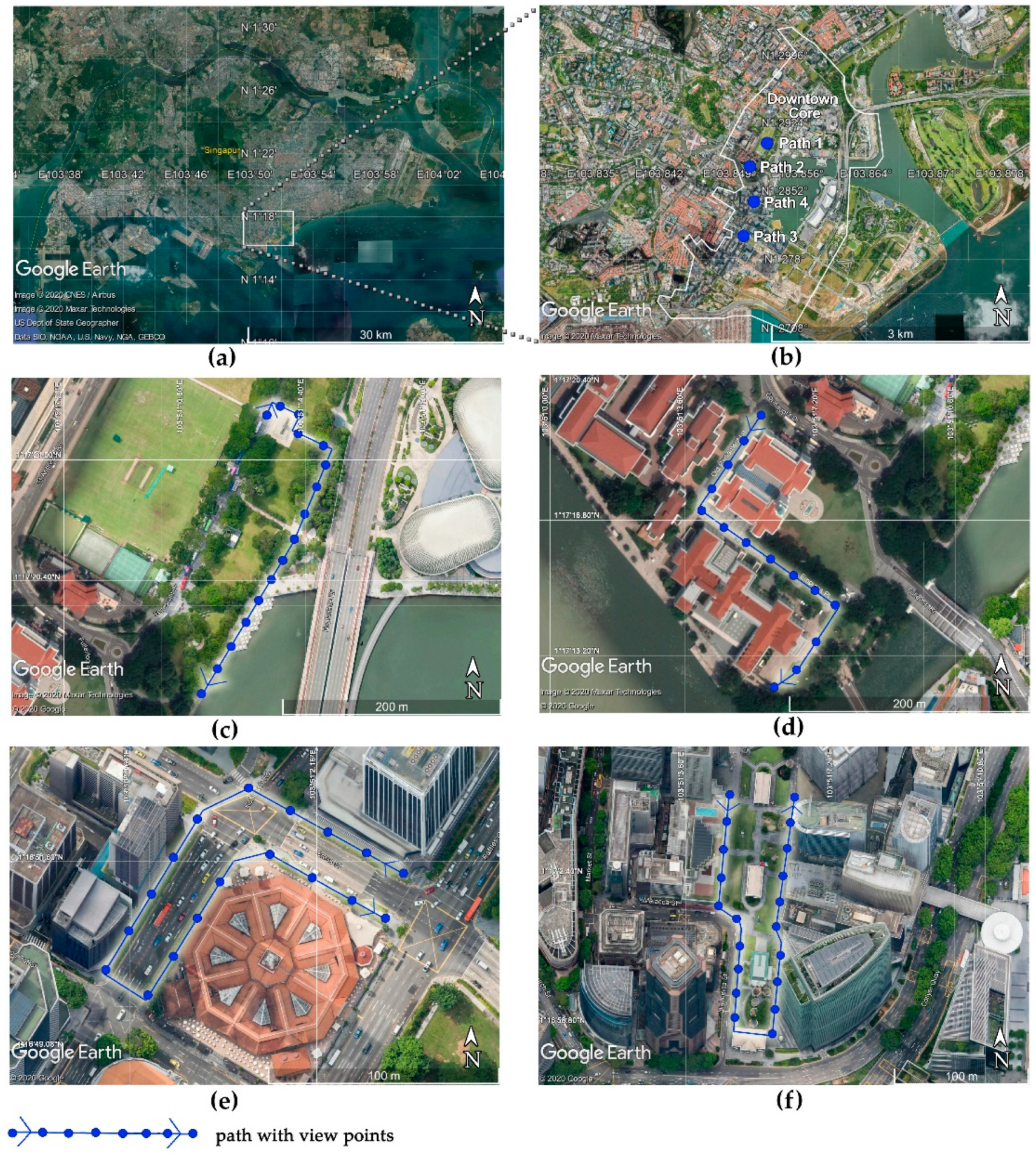
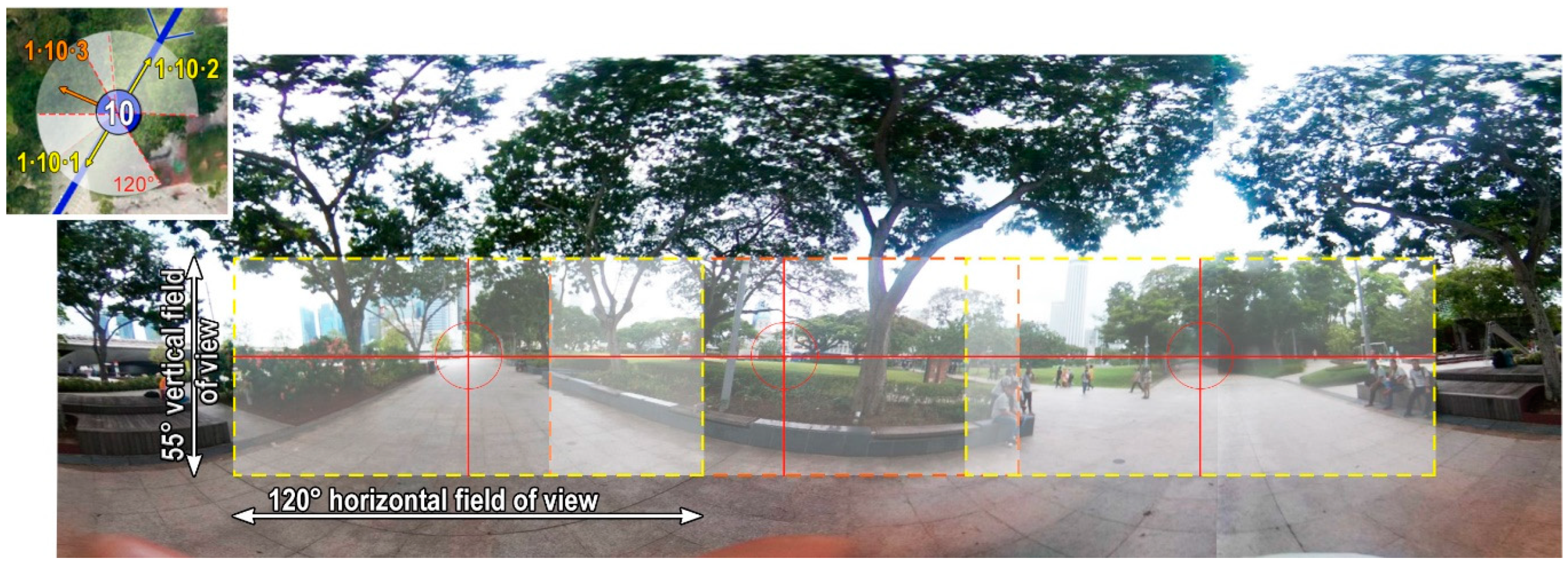
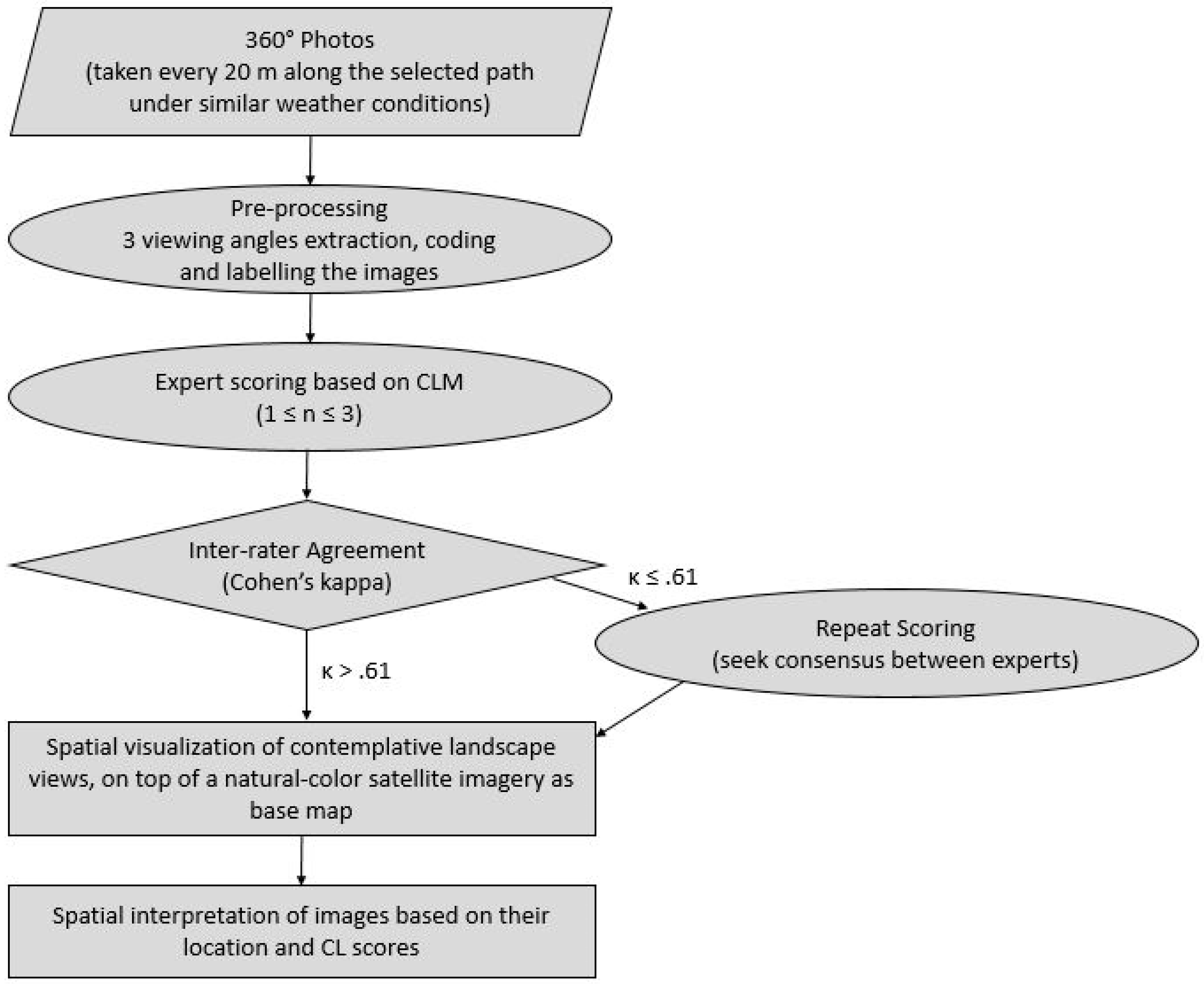
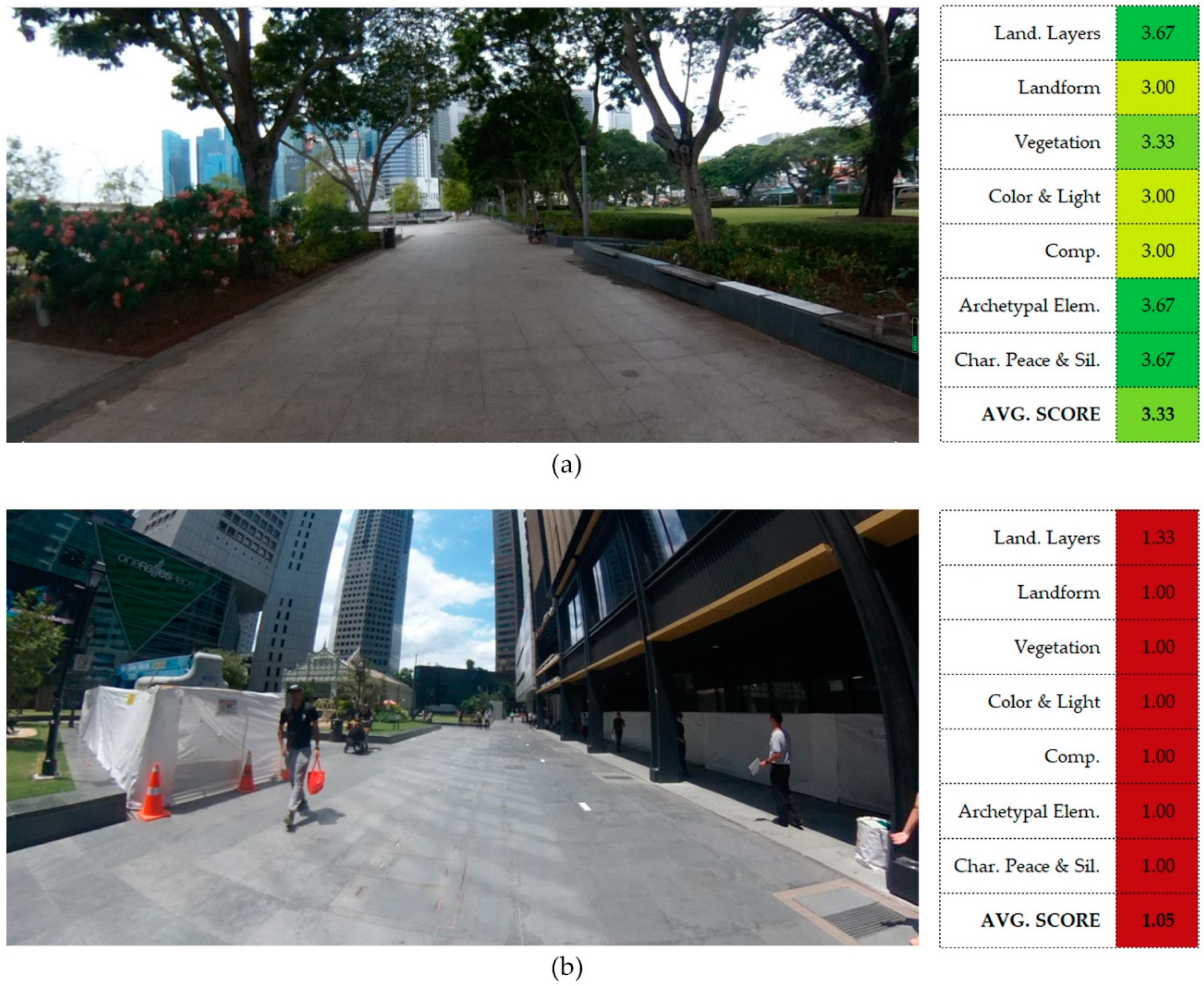
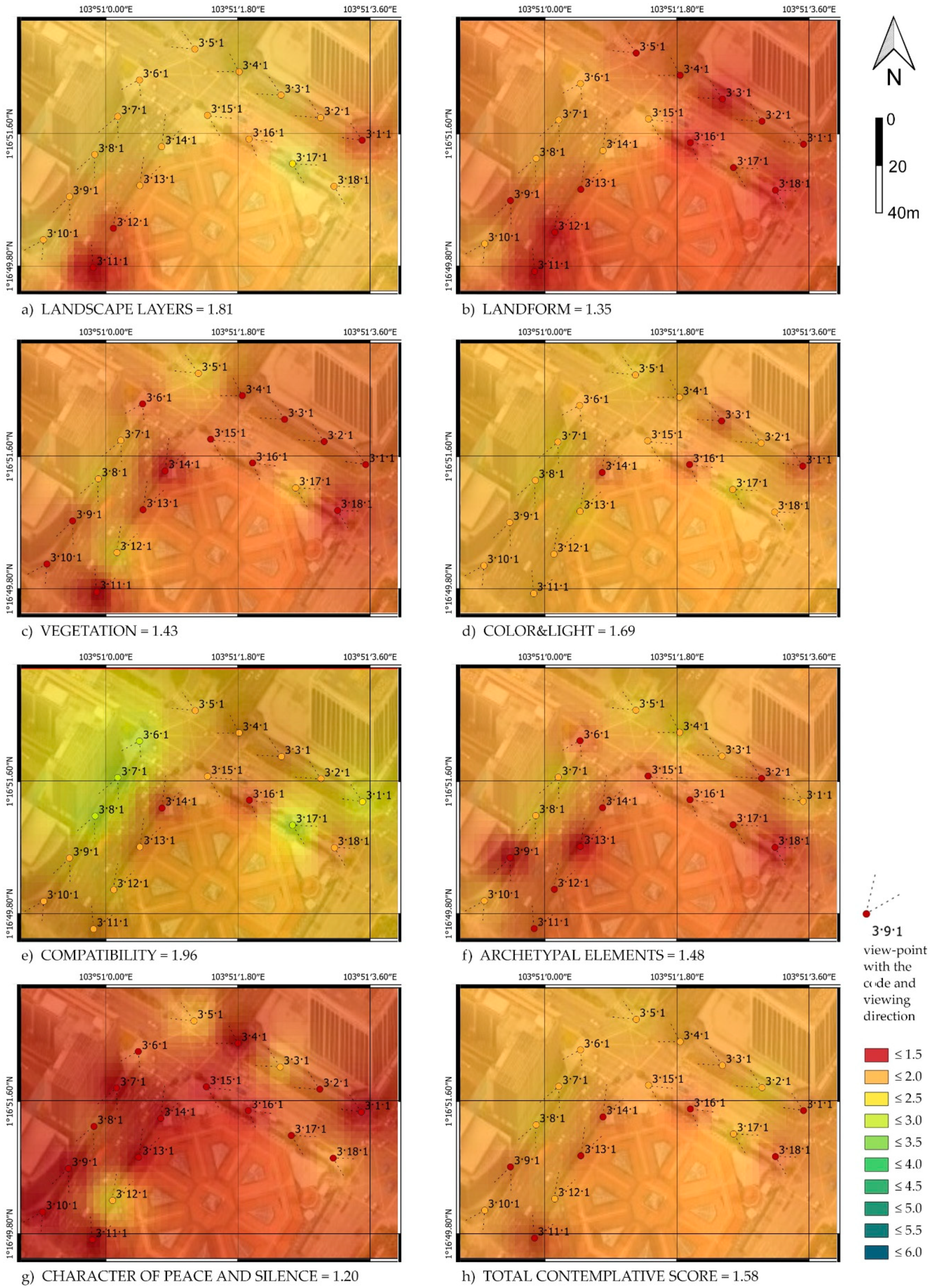

| Path 1-Esplanade Park | Path 2-Museum Area | Path 3-Robinson Road | Path 4-Raffles Place Park | |
|---|---|---|---|---|
| Landscape Layers | 2.89 | 2.02 | 1.73 | 1.46 |
| Landform | 2.24 | 1.76 | 1.38 | 1.10 |
| Vegetation | 2.44 | 1.60 | 1.40 | 1.22 |
| Color & Light | 2.85 | 1.97 | 1.67 | 1.30 |
| Compatibility | 2.76 | 2.11 | 1.88 | 1.57 |
| Archetypal Elements | 3.28 | 1.93 | 1.54 | 1.36 |
| Character of Peace and Silence | 3.25 | 2.07 | 1.18 | 1.35 |
| TOTAL CL SCORE | 2.81 | 1.92 | 1.54 | 1.34 |
Publisher’s Note: MDPI stays neutral with regard to jurisdictional claims in published maps and institutional affiliations. |
© 2020 by the authors. Licensee MDPI, Basel, Switzerland. This article is an open access article distributed under the terms and conditions of the Creative Commons Attribution (CC BY) license (http://creativecommons.org/licenses/by/4.0/).
Share and Cite
Yanru, H.; Masoudi, M.; Chadala, A.; Olszewska-Guizzo, A. Visual Quality Assessment of Urban Scenes with the Contemplative Landscape Model: Evidence from a Compact City Downtown Core. Remote Sens. 2020, 12, 3517. https://doi.org/10.3390/rs12213517
Yanru H, Masoudi M, Chadala A, Olszewska-Guizzo A. Visual Quality Assessment of Urban Scenes with the Contemplative Landscape Model: Evidence from a Compact City Downtown Core. Remote Sensing. 2020; 12(21):3517. https://doi.org/10.3390/rs12213517
Chicago/Turabian StyleYanru, Hou, Mahyar Masoudi, Agnieszka Chadala, and Agnieszka Olszewska-Guizzo. 2020. "Visual Quality Assessment of Urban Scenes with the Contemplative Landscape Model: Evidence from a Compact City Downtown Core" Remote Sensing 12, no. 21: 3517. https://doi.org/10.3390/rs12213517
APA StyleYanru, H., Masoudi, M., Chadala, A., & Olszewska-Guizzo, A. (2020). Visual Quality Assessment of Urban Scenes with the Contemplative Landscape Model: Evidence from a Compact City Downtown Core. Remote Sensing, 12(21), 3517. https://doi.org/10.3390/rs12213517






